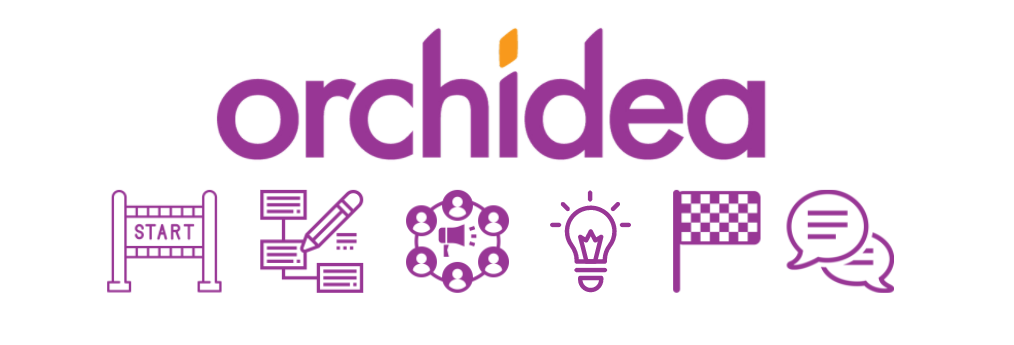What are challenges?
Challenge: ideas for achieving goals and solving problems

Challenge, innovation challenge and innovation competition. These are some examples for what Orchidea's Challenge tool can be used to.
Challenge is used alongside the ongoing collection of proposals when the creativity of the community (staff, customers, consumers) is to be focused on solving or developing a chosen problem, goal or theme.
As a campaign of limited duration, challenge is the best way to involve especially external stakeholders such as customers, consumers and partners, who can be difficult to engage in continuous co-creation.

Which question does challenge answer? What is being solved, for whom and why?
When creating a challenge, it is important to define the topic well and clearly so that it is clear to everyone what you are trying to solve.
Answer the following questions:
- What is the solution needed?
- Who or what is the challenge?
- Who are you inviting to come up with ideas?
- Why do we need solutions?
- Who is best placed to evaluate the proposals for the challenge.

Plan the challenge and its info text well
Plan a schedule for the challenge. Time dedicated to challenge depends on the number of participants, the topic, their knowledge of the topic and the communication.
It's suggested to set aside 2-4 weeks to collect ideas and to develop a solid communication plan for the process of a challenge.
One of the most important things to plan is the goal. What do you hope to achieve? Is it the number or quality of ideas or the number of ideas implemented at the end of the challenge competition?

Publish a challenge and think about who to invite
When publishing a challenge, consider things like:- Is the challenge internal?
- Would customers or partners be helpful in brainstorming?
- Are anonymous responses allowed?
It is important to keep communication open and remind participants of the challenge throughout the idea collection process. This will ensure that the topic is still on the minds of participants and that enthusiasm remains after the launch.

Collect, develop and evaluate ideas
After challenge launch, it's time to start collecting ideas. To do this, you need to start by telling your audience that you are interested in hearing their ideas. You can do this by sending an email to your target audience and posting an announcement on sites like Teams, Slack or your intranet.
Message about the progress of the challenge
Be sure to keep your challenge participants informed about where you are in the challenge. Orchidea will always send a message to participants when a stage changes, but if the stages are long, it's a good idea to communicate progress between stages as well.

Decisions and how to reward best idea creators
Once the ideas have been evaluated, it is time to make the final decisions on which ideas to reward and which to implement. The selections will be made primarily on the basis of numerical evaluations, but it is still a good idea to go through them and discuss what the evaluators base their choices on.
Intrinsic motivation to participate is key to the success of innovation activities. External motivators can still be of significant benefit. It is therefore important to reward the participants and especially the proposers of the selected ideas. The rewards do not have to be large, depending on the challenge and its size, a simple email thank you may be sufficient, while an online gift card could be an appropriate reward for the solver of a larger challenge.

Post-challenge communication
Post-project communication is an essential part of the process.
Let participants know that the challenge is over and thank them for their participation. It is important that you thank them for completing the challenge to show that their participation was valuable. Also share the solutions, the benefits achieved and the new ways of working based on the challenge.
For future challenges, collect and provide feedback to improve the activity.
👉 More information about holding a challenge: Innovation challenge - the complete guide
![Orchidea logo white with orange dot.png]](https://knowledge.orchidea.dev/hs-fs/hubfs/Orchidea%20logo%20white%20with%20orange%20dot.png?width=161&height=51&name=Orchidea%20logo%20white%20with%20orange%20dot.png)